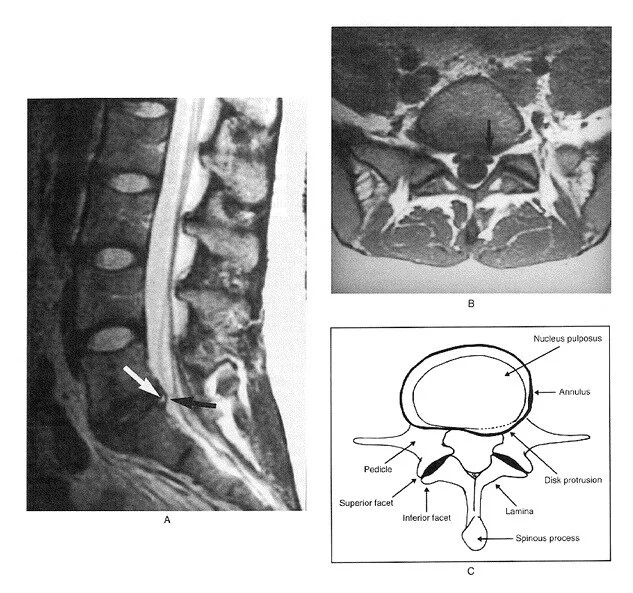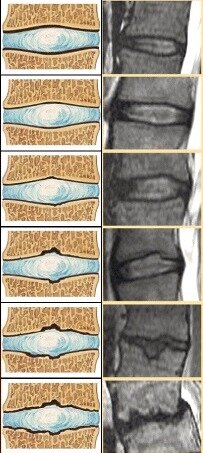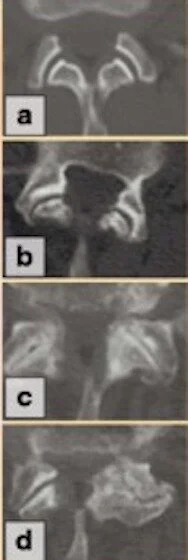MRI - What is Normal ?
Why MRI findings may not be important :
2/3 rds of people without back pain can have disc herniations ( protrusions).
Early spine degeneration in adolescents with low back pain is associated with increasing degeneration and disc herniation in adulthood, but it was not associated with severe low back pain or increased frequency of spinal surgery
Early MRI in the workup of Back pain were more likely to have prolonged disability, higher medical costs, and greater utilization of surgery
Over time, both disc herniations causing pain, and disc herniations not causing pain, will decrease in size on MRI. The finding of disc disease (degeneration or herniation) on MRI does not correlate with the likelihood of chronic pain or the future need for surgery
selecting treatments on the basis of the presence of the most common imaging findings does not improve outcomes compared with a generalized approach.
Among patients with lumbar imaging abnormalities before the onset of low back pain, 84% had unchanged or improved findings after symptoms developed.
Disc Herniation in a 24 year old woman with no back pain
Disc degenerative disease (between vertebrae) from none to severe
Facet joint degenerative disease from none to severe
Spondylolisthesis: It is the slipping of one vertebrae over another, mostly due to degenerative disease, and some times due to small fractures behind. Either way, most spondylolisthesis, do not have a clinical symptom; even severe spondylolisthesis subjects can be asymptomatic. They tend to be more associated with pain only in occupations that tend to bend forward a lot.
A/B show slipping of one vertebrae over another (spondylolisthesis) due to degenerative disease
C/D show slipping of one vertebrae over another (spondylolisthesis) due to fracture behind.
Mild grade 1 (less than 25%) spondylolisthesis (slipping of one vertebra over another). In this case, associated with disc herniation.
Degenerative spondylolisthesis can occur in >50 year age group without symptoms
Findings on MR imaging within 12 weeks of serious low back pain onset are highly unlikely to represent any new changes.
References:
Maureen C. Jensen, Michael N. Magnetic Resonance Imaging of the Lumbar Spine in People without Back Pain.N Engl J Med 1994; 331:69-73
Eero Waris; Marja Eskelin. Disc Degeneration in Low Back Pain: A 17-Year Follow-up Study Using Magnetic Resonance Imaging. Spine. 32(6):681-684, MARCH 15TH, 2007
Webster BS, Cifuentes M. Relationship of early magnetic resonance imaging for work-related acute low back pain with disability and medical utilization outcomes. J Occup Environ Med. 2010;52:900–7
Chester J. Donnally III; Andrew Hanna; Matthew Varacallo. Lumbar Degenerative Disk Disease. Stat Pearls.https://www.ncbi.nlm.nih.gov/books/NBK448134/
Shah LM, Ross JS. Imaging of Degenerative and Infectious Conditions of the Spine. Neurosurgery. 2016 Sep;79(3):315-35.
Anderson JT, Haas AR, Percy R, Woods ST, Ahn UM, Ahn NU. Lumbar Diskography and Failed Back Syndrome in Patients Receiving Workers' Compensation. Orthopedics. 2015 Nov;38(11):e951-8
Brinjikji W, Luetmer PH, Comstock B, et al. Systematic literature review of imaging features of spinal degeneration in asymptomatic populations. AJNR Am J Neuroradiol. 2015;36(4):811–816. doi:10.3174/ajnr.A4173
Kushchayev SV, Glushko T, Jarraya M, et al. ABCs of the degenerative spine. Insights Imaging. 2018;9(2):253–274. doi:10.1007/s13244-017-0584-z
R. Chou, A. Qaseem, V. Snow, et al., Clinical Efficacy Assessment Subcommittee of the American College of PhysiciansDiagnosis and treatment of low back pain: a joint clinical practice guideline from the American College of Physicians and the American Pain Society. Ann Intern Med, 147 (2007), pp. 478-49
E. Carragee, T. Alamin, I. Cheng, T. Franklin, E. van den Haak, E. HurwitzAre first-time episodes of serious LBP associated with new MRI findings?Spine J, 6 (2006), pp. 624-635
Y.X. Wang, Z. Kaplar, M. Deng, J.C. LeungLumbar degenerative spondylolisthesis epidemiology: a systematic review with a focus on gender-specific and age-specific prevalence. J Orthop Transl, 11 (2016), pp. 39-52
Y.X. Wáng, M. Deng, J.F. Griffith, A.W. Kwok, J.C. Leung, A.T. Ahuja, et al.Lumbar spondylolisthesis progression and de novo spondylolisthesis in elderly Chinese men and women: a year-4 follow-up study. Spine (Phila Pa 1976), 41 (13) (2016), pp. 1096-1103
North American Spine SocietyClinical guidelines for multidisciplinary spine care. Diagnosis and treatment of degenerative lumbar spondylolisthesisNorth American Spine Society, Burr Ridge, USA (2014 revised)
E. Carragee, T. Alamin, I. Cheng, T. Franklin, E. van den Haak, E. HurwitzAre first-time episodes of serious LBP associated with new MRI findings? Spine J, 6 (2006), pp. 624-63
What else can we add or work on? Please let us know in the comments. No need to log in…






